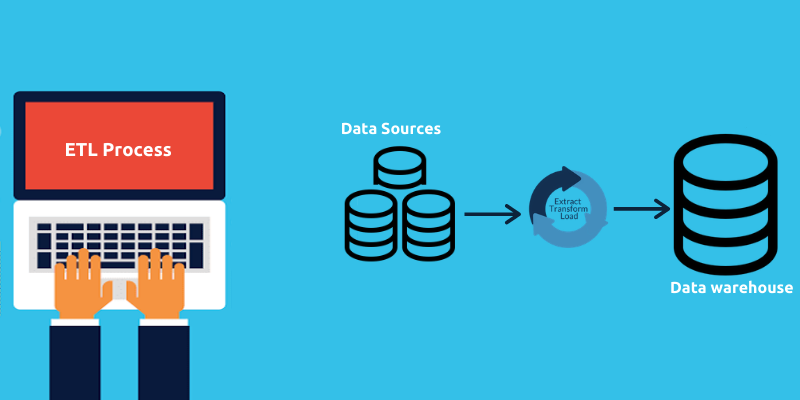ETL, which is Extract, Transform, and Load, is a procedure that excerpts the data from diverse source structures and later converts the data such as smearing controls, concatenations, and so on. It ultimately masses the information to the Data Warehouse structure. It’s alluring to have a thought about making a Data warehouse is merely extracting data from several sources to a Data warehouse. However, the procedure needs a multifaceted ETL procedure. The ETL procedure needs active involvement from numerous participants such as analysts, developers, top-most executives, testers, and so on, which is very technically challenging.
The Data warehouse structure requires changing as and when the business changes so that it preserves its worth as a tool for making an important decision. ETL is a recurrent activity that keeps changing every day, weekly, and even months of a Data system and requires agile, automatic, and adequately documented. The ETL procedure is even called as a Data Integration procedure. ETL can take care of data management, data migration, data cleansing, data harmonization, and data alliance.
Target Audience
- Data warehouse, testers, and data migration.
- Database specialists are having fundamental information regarding the concepts of the database.
- Database administrators and tremendous data professionals who are wanted to know Data warehouse and ETL areas.
- University freshers or even graduates who are depending on Data warehouse as their careers.
- The one who makes use of ETL?
ETL tools are mostly graphic design tools that let the firms create the database visually compared to the programming methods. Many companies and corporations that require to shape and preserve multifaceted information warehouses capitalize on ETL and ETL tools. Nonetheless, further companies might use them on a lesser scale. IBM InfoSphere DataStage, Pentaho Data Integration, Informatica PowerCenter, Jasper ETL, and so on are some of the prominent tools.
Why use ETL?
Businesses have always depended on the ETL process from the past many years to achieve a combined opinion of all the data. ETL permits companies to examine the data that stays in manifold settings in a diversity of arrangements, rationalize the studying procedure, and pour the best final decisions in business.
Benefits of ETL explained
- ETL changes information from manifold sources and heaps it into numerous targets.
- It offers a profound past framework for industries.
- It lets many firms to examine and note it on data quite professionally and effortlessly.
- Increases efficiency as it rapidly changes data without needing any technical services for having code knowledge.
- Changes and familiarizes to altering expertise and incorporation strategies.
The significance of ETL in Business Intelligence
Businesses depend entirely on the ETL procedure for a combined data opinion to give the right business decisions. Below are some benefits of ETL data integration that helps many businesses of today:
1. High-level Data Mapping
Leveraging information and converting them to an understanding is difficult, along with the discrete and massive data. But with the help of a data mapping database, functionalities can be simplified, such as incorporation, relocation, warehousing, and conversion. ETL lets planning data for particular apps. Data mapping even benefits in starting an association among dissimilar data replicas.
2. ETL Business Applications
Provisional information bases are insufficient to determine complex business inquiries. Additionally, managing sloppy information designs is additional time-taking. ETL does benefit from acquiring below
- Memory competence
- Real-time inquiry procedure
- Charting information past, present, and predictive statistics to originate legal understandings
- Nifty storage of data and retrieving it
3. Operational Flexibility
Numerous data warehouses are breakable and provide an increase in functioning difficulties. ETL tools have its in-built problem-handling function that aids data engineers to create on the aspects of an ETL tool to design a hardy and properly instrumented ETL structure.
4. High Return on Investment (ROI)
The use of ETL tools saves prices, thus allowing industries to make more massive revenue because of cost savings.
5. Fault broad-mindedness
In all the systems, glitches unavoidably happen. ETL schemes do recuperate elegantly, assuring that data could be made from one pipeline to the other end of the pipeline even when they first track happenstances difficulties.
6. Notification support
There is essential to create a notification method in case you wish that your company must trust the investigates; you need to be attentive to you when information is not correct.
7. Improved quality and constancy
Data warehouse placement includes adapting facts and figures from many sources and changes into a joint format. This means that data from manifold business sections and procedures is consistent and dependable.
Obviously, when information warehousing is executed and planned appropriately, it can give huge advantages of focal points to your business.
Summary:
- ETL is Extract, Transform, and Load.
- ETL offers a technique of shifting the information from numerous sources to the single data warehouse.
- The initial step is extraction to the staging area.
- The second step is the transformation step.
- The last step of the ETL process is loading data to a Data warehouse.
- It increases competence, effectiveness, and complete success.
More Stuff For Your Inspiration:
- No Related Posts
Related posts
Follow us
Categories
- Around The World (369)
- Business (57)
- Education (9)
- Home Improvement (23)
- Humor (191)
- Inspiration (512)
- Lifestyle (21)
- Motivation (2)
- News (31)
- Photo of the Day (257)
- Photography (105)
- Technology (58)
- Travel (8)


